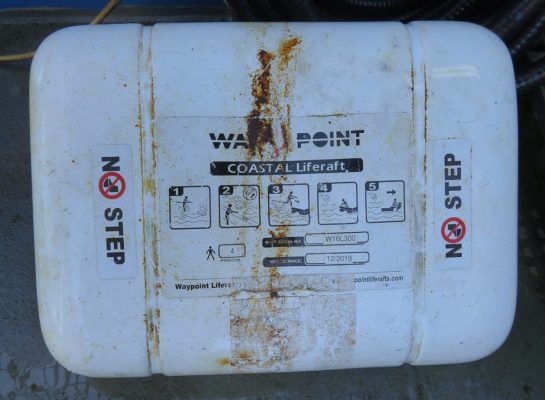All non-SOLAS float-free launching liferafts must now have sufficient buoyancy to trigger the inflation mechanism once it has been released from the cradle
New liferaft buoyancy standards have been introduced for all non-SOLAS float- free-launching liferafts following an investigation into the sinking of a scallop dredger and the deaths of two of her three crew members.
The Joanna C sank five miles south of Newhaven, East Sussex on 21 November 2020 after dredging gear became snagged on a link of whelk pots, causing the boat to capsize rapidly.
The boat’s four-man Waypoint Coastal liferaft was fitted with a green Hammar hydrostatic release unit.
It was released but the liferaft failed to inflate because of insufficient buoyancy to trigger the inflation mechanism.
The Marine Accident Investigation Branch (MAIB) found that the liferaft spent time inverted in the water, allowing air to escape and water to ingress into the canister via the drain holes, stopping its buoyancy generating sufficient force to inflate the liferaft, leaving it suspended mid-water, still tethered to the sunken vessel.

Two of Joanna C‘s three crew members died during the accident. Credit: MAIB
Dive survey footage showed that the rubber grommet impeded the painter, and the activation mechanism was stuck on the trigger.
Post-accident testing of the liferaft revealed buoyancy to overcome the inflation activation force of 247N only occurred after initial immersion.
The MAIB highlighted that the liferaft’s gas inflation system was functional, despite the liferaft being nearly a year overdue for a service at the time of the fatal accident, but the liferaft was not constructed to or required to meet any industry minimum standard for buoyancy in the uninflated state.
Liferafts for leisure sailors are governed by International Standards Organisation (ISO) rules, under standard ISO 9650, and this standard has now been revised to include a buoyancy requirement for uninflated canister-packed liferafts with float- free, automatic inflation devices.
Continues below…
Why a yacht makes the best liferaft
A liferaft is reassuring, but only to be used as an absolute last resort. James Stevens explores the main scenarios…
Why you should get to know your liferaft
It is easy to buy the cheapest liferaft and then forget about it, but do you know how to use…
Sunk in a storm with no liferaft: lessons learned
Bruce Goodwin's ocean crossing with friends was nearing an end when they encountered a storm; the liferaft was lost, the…
We Tested 16 of the Best Lifejackets for Boating and Sailing
We all have lifejackets on board, but do you know what yours is actually like to use? We test 10…
The buoyancy requirement of an uninflated liferaft and its canister should now be sufficient to exceed, by a suitable factor of safety, the force required to activate the liferaft’s inflation mechanism.
The recommendation by the MAIB has been accepted by the British Standards Institution.
The chief inspector of marine accidents, Andrew Moll said the investigation’s findings applied ‘beyond the fishing industry to any vessel carrying a ‘non-SOLAS’ liferaft.’
He said the failure of Joanna C’s float-free liferaft to inflate ‘significantly impacted the chances of survival for the two crew in the water, only one of whom survived’. The other crew member was trapped inside the boat.
‘The safety message is that it is vital to ensure that lifesaving appliances will work as expected. The liferaft must have sufficient buoyancy to trigger the inflation mechanism once it has been released from the cradle as the vessel sinks,’ added Moll.
Read the full MAIB report here.
Enjoyed reading New liferaft buoyancy standards after fatal accident?
A subscription to Yachting Monthly magazine costs around 40% less than the cover price.
Print and digital editions are available through Magazines Direct – where you can also find the latest deals.
YM is packed with information to help you get the most from your time on the water.
-
-
- Take your seamanship to the next level with tips, advice and skills from our experts
- Impartial in-depth reviews of the latest yachts and equipment
- Cruising guides to help you reach those dream destinations
-
Follow us on Facebook, Twitter and Instagram.









